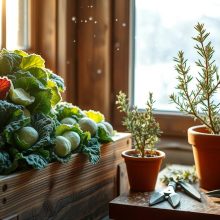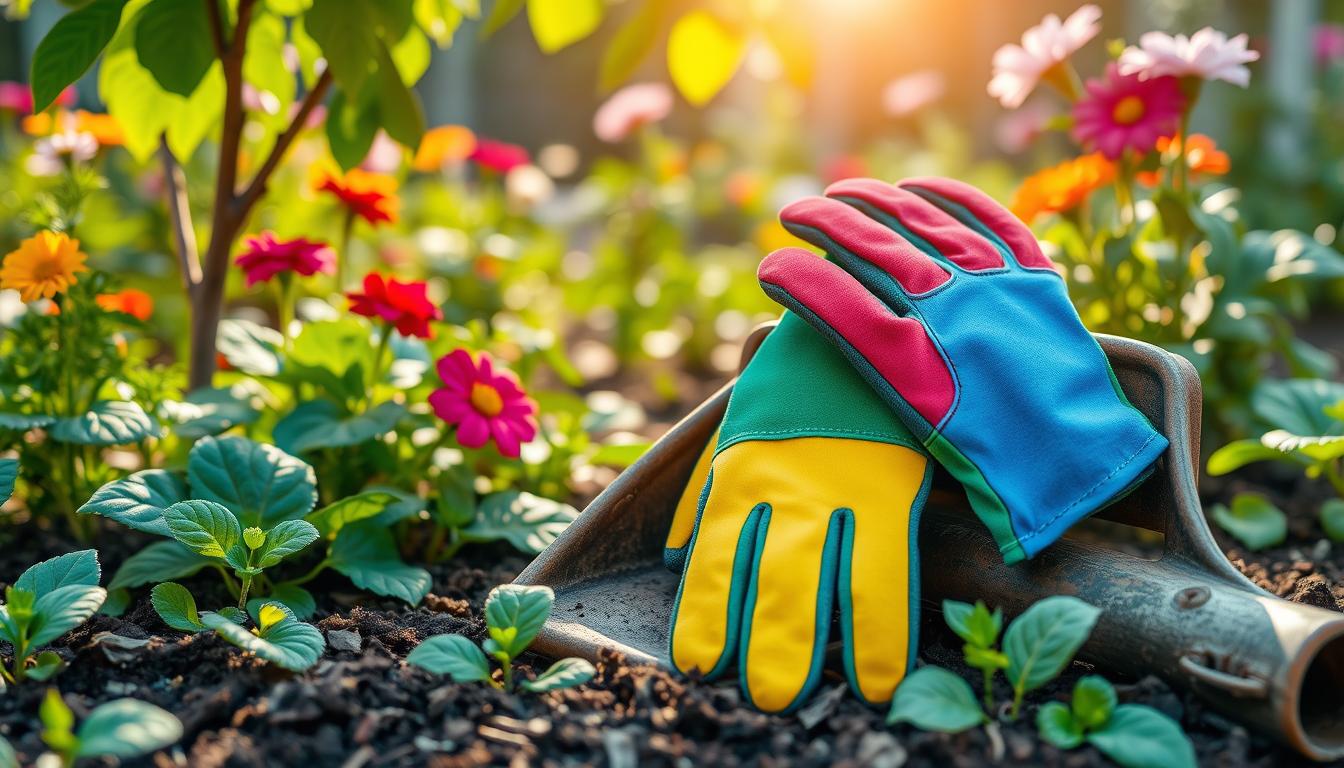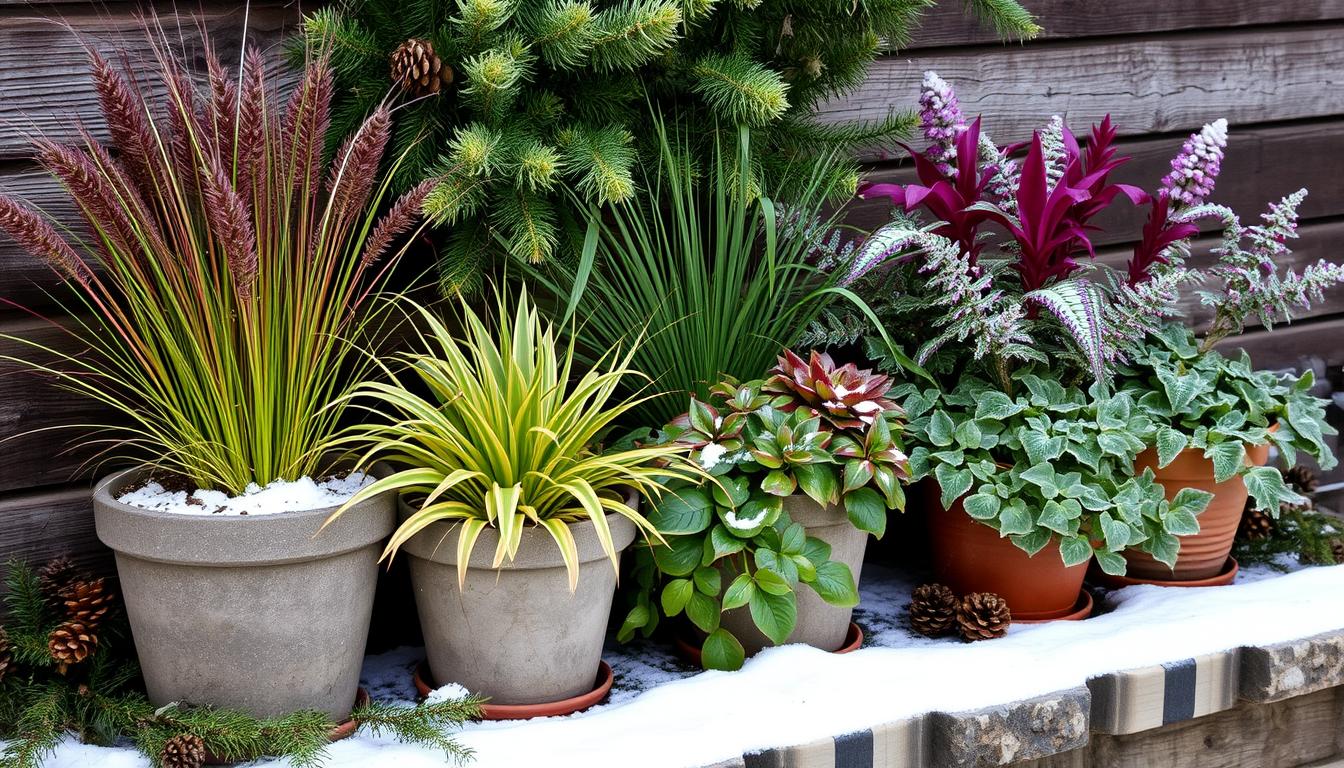Winter Gardening Essentials: Cultivate a Lush Cold-Weather Oasis
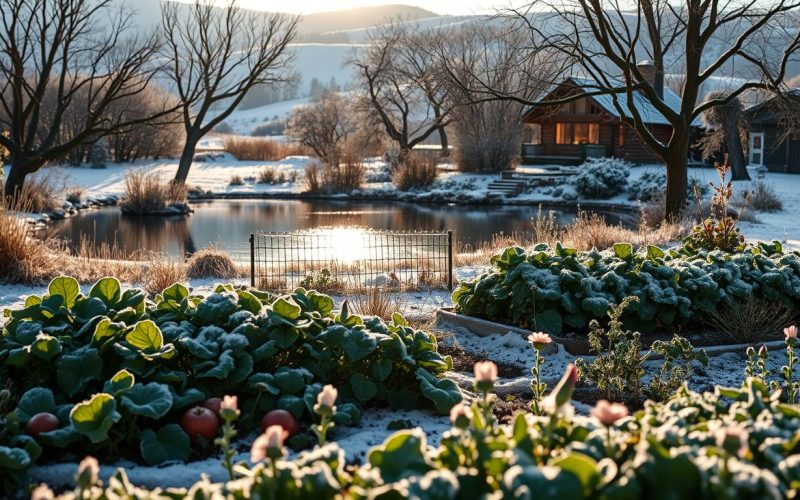
Winter gardening turns cold landscapes into vibrant green spaces. Many think gardens sleep during the cold, but gardeners know how to keep them alive. They create engaging ecosystems that grow and inspire.
To care for winter gardens, you need a plan and special techniques. Gardeners make landscapes strong against harsh weather by choosing the right plants and using protection. Whether you’re experienced or new, winter gardening is a chance to see plants thrive.
This guide will show you how to make winter gardens lush. You’ll learn about picking plants that can handle the cold and how to protect them. You’ll see how to keep your garden beautiful even in the coldest months.
Key Takeaways
- Winter gardens can be just as vibrant as summer landscapes
- Strategic plant selection is crucial for cold weather gardening
- Proper protection techniques ensure garden survival
- Winter provides unique opportunities for garden creativity
- Consistent maintenance prevents plant damage during cold months
Understanding Winter Gardening Benefits
Winter gardening turns the cold season into a time for fun for plant lovers. Many think gardening stops when it gets cold. But winter gardening brings its own set of benefits that go beyond the usual growing seasons.
Winter gardening tips can make your outdoor spaces and mood better. It’s a creative way to stay active during the cold months.
Why Winter Gardening Matters
Winter gardening is important for those who love plants:
- It keeps landscapes lively in the cold
- It helps you stay connected with nature
- It’s good for your mental health
- It keeps your gardening skills sharp
Enhancing Your Home’s Aesthetic
Smart winter gardening can make your outdoor space look amazing. Using evergreen plants, colorful winter veggies, and hardscape elements adds beauty when other gardens are bare.
Connecting with Nature in the Cold
Winter gardening tips help you stay close to nature’s cycles. By learning about plant resilience and microclimates, you can grow thriving gardens even in tough weather.
Embracing winter gardening lets you find beauty in unexpected places. It’s about growing hardy veggies or keeping ornamental plants alive. This way, your garden stays a lively haven all year round.
Choosing the Right Plants for Winter
Winter gardening is a chance to make your garden vibrant, even when it’s cold. Picking the right plants can turn your garden into a strong and fruitful space. It will thrive, even in freezing temperatures.
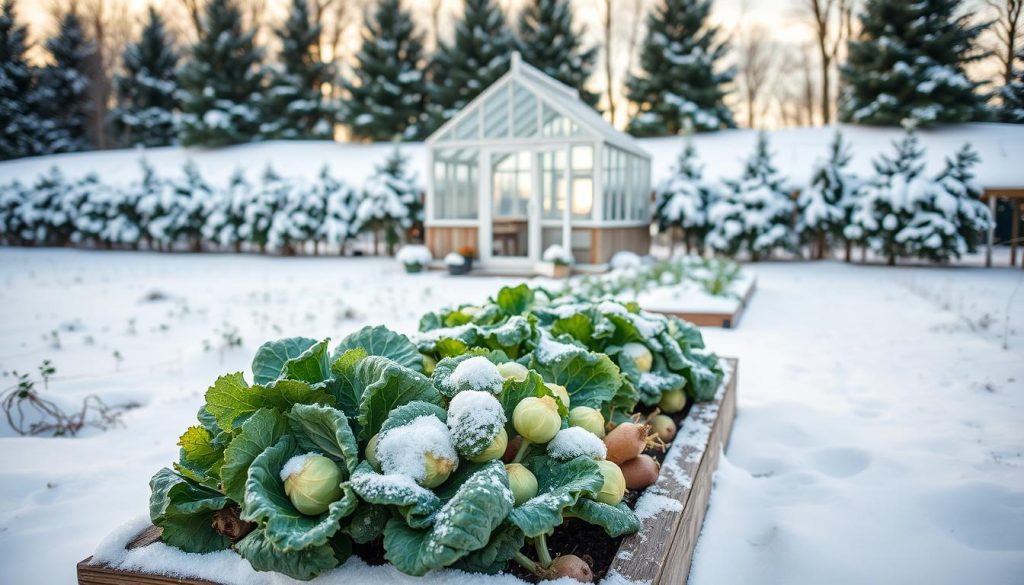
Choosing the right vegetables for winter gardening is key. Some veggies are made to handle cold and can give you fresh food all winter.
Cold-Hardy Vegetables to Consider
Vegetables from the Brassica family are great for winter gardens. They not only handle cold well but also get sweeter after frost.
- Broccoli: Tolerates temperatures down to 28°F
- Kale: Extremely cold-hardy, improves flavor with frost
- Collard greens: Maintains nutritional value in low temperatures
- Brussels sprouts: Develops enhanced sweetness during winter
- Cabbage: Withstands freezing conditions effectively
Best Evergreens for Winter Interest
Evergreen plants keep your garden looking good even when it’s not growing. They add structure and color when other plants are scarce.
- Boxwood shrubs
- Holly plants
- Juniper varieties
- Pine trees
Perennials That Thrive in Cold Weather
Some perennials are built for winter, coming back year after year with little care. They are the backbone of a winter garden.
- Hellebores
- Winter jasmine
- Sedum
- Ornamental grasses
Knowing which plants do well in your area is crucial. It helps you build a garden that’s both beautiful and resilient, no matter the season.
Preparing Your Garden Before Winter
Winter garden care needs careful planning. Gardeners can keep their gardens safe from cold weather. They do this by using important winter gardening tips.
Good winter gardening starts with thorough garden prep. The right steps help plants survive cold and grow strong in spring.
Essential Soil Preparation Techniques
Soil prep for winter is key:
- Remove dead plant debris and weeds
- Test soil pH and nutrient levels
- Add organic matter to improve soil structure
- Ensure proper drainage to prevent water logging
Mulching for Winter Protection
Mulching is vital in winter garden care. It keeps soil warm, holds moisture, and protects roots from frost.
- Apply 2-3 inches of organic mulch around plants
- Use materials like straw, wood chips, or leaves
- Keep mulch away from plant stems to prevent rot
Winter Fertilization Strategies
Winter fertilization is important for plant health. Use slow-release fertilizers that give steady nutrition without promoting new growth.
- Choose balanced, low-nitrogen fertilizers
- Apply fertilizer before first frost
- Focus on root system strengthening
By using these winter gardening tips, gardeners can make their landscapes strong. They can survive and even thrive in cold weather.
Creating Shelter and Protection
Winter gardening needs smart protection to keep plants safe from cold. It’s key to shield your garden from freezing, wind, and snow. This helps plants stay healthy during the coldest times. Creating protective structures is a great way to extend your growing season and protect your plants.
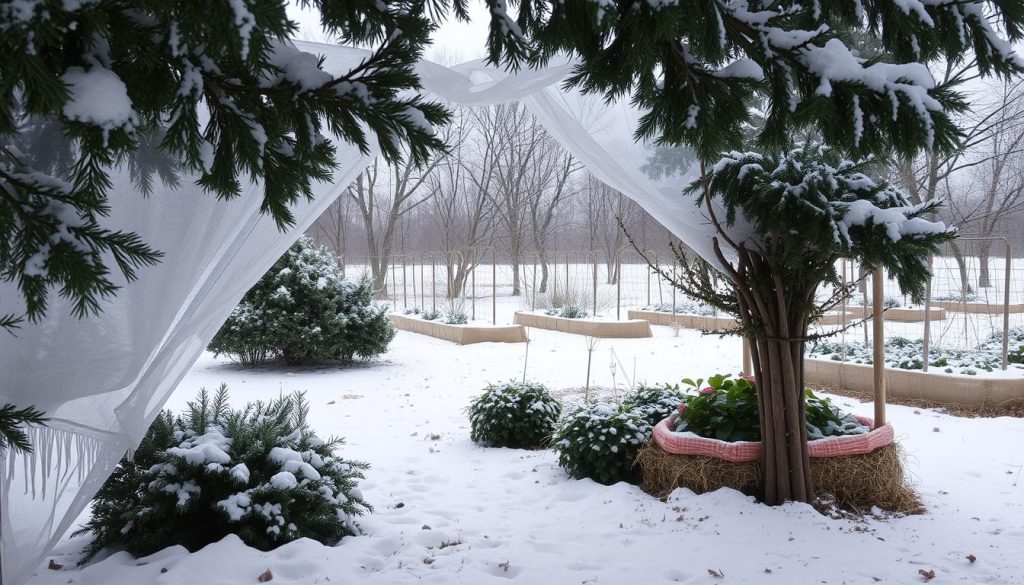
Building a Simple Cold Frame
Building a cold frame is easy with basic materials. It works like a mini-greenhouse, trapping heat and keeping plants safe from extreme cold.
- Select a sunny location in your garden
- Use recycled wooden boards or lumber
- Create a rectangular box with a transparent lid
- Angle the lid to maximize sunlight exposure
Using Row Covers Effectively
Row covers are a great choice for winter gardening. They block frost, wind, and pests but let light and moisture through to your plants.
- Choose the right fabric weight for your area
- Secure covers with landscape pins or weights
- Take off covers when it gets warmer during the day
- Keep an eye on your plants for moisture and air
Recycling Materials for Garden Protection
Repurposing items is a creative way to protect your garden. You can use plastic bottles, old windows, and spare lumber to make shelters without spending a lot.
- Use plastic milk jugs to protect individual plants
- Make wind barriers with old window frames
- Wrap sensitive plants with burlap sacks
- Use straw bales as insulating barriers
Watering and Irrigation Practices in Winter
Winter garden care needs a careful touch when it comes to watering. Plants change a lot in cold months, and knowing how much water they need is key. Gardeners must find the right balance to avoid too much or too little water.
Adjusting Your Watering Schedule
In winter, most plants slow down and grow less. This means they need less water. Here are some important tips for watering in winter:
- Check soil moisture before watering
- Water during warmer midday hours
- Reduce watering frequency by 50-70%
- Use room temperature water
Benefits of Winter Watering
Good winter garden care means watering wisely to protect roots and prevent damage. Keeping plants moist helps them stay strong and get ready for spring. Even though plants seem dormant, their roots keep working and need water.
Signs Your Plants Need More Water
It’s important to know when plants are thirsty in winter. Look out for these signs:
- Dry, brittle leaf edges
- Soil pulling away from container sides
- Drooping or wilting plant structures
- Unusual discoloration of leaves
Winter watering is about being precise, not just about how much water you use. By understanding your plants’ needs, you can help them survive and thrive in the spring.
Winter Gardening Tools and Supplies
Cold weather gardening needs special tools and preparation. To succeed, you need the right equipment, protective gear, and knowledge. This guide will help you get ready for a successful winter gardening season.
Essential Tools for Cold-Weather Gardening
For winter gardening, you need quality tools that can handle harsh weather. Your toolkit should include:
- Heavy-duty pruning shears
- Insulated gardening gloves
- Sturdy garden spade
- Soil testing kit
- Moisture-resistant wheelbarrow
Recommended Soil Amendments
Soil preparation is key in winter gardening. A soil testing kit helps check pH levels and nutrients. Important soil amendments are:
- Organic compost
- Aged manure
- Lime (for acidic soils)
- Sulfur (for alkaline soils)
Winter Gardening Apparel Must-Haves
Staying warm and protected is vital in cold weather gardening. Choose outdoor gear that’s waterproof, breathable, and insulating. It should also allow for easy movement while you work in the garden.
With the right tools, soil amendments, and warm clothing, winter gardening can be fun and rewarding. Get ready and enjoy the unique challenges of gardening in the cold.
Designing Your Winter Garden Layout
Winter Gardening turns outdoor areas into stunning, useful spaces that delight us, even when it’s cold. A well-planned winter garden is more than just surviving—it’s a lively, welcoming spot that brings joy and connects us with nature.
Good design starts with knowing what winter landscapes can do. By picking the right plants, adding hardscape features, and making special areas, gardeners can make a cozy outdoor spot.
Planning for Color and Texture
Winter gardens need variety to look good. Think about plants that stand out in the cold:
- Evergreen shrubs with unique bark
- Plants with colorful berries
- Ornamental grasses that add structure in winter
- Hardy perennials with interesting seed heads
Incorporating Hardscape Features
Hardscape elements are key in winter garden design. Stone paths, decorative walls, and buildings add interest when plants are asleep. These features give your winter garden shape and definition.
Creating Gathering Spaces
Make your Winter Gardening area a welcoming outdoor room. Add:
- Sheltered seating areas
- Fire pits for warmth
- Wind-protected nooks
- Outdoor lighting for evening charm
With careful planning, your winter garden becomes a lively, engaging place that celebrates winter’s beauty.
Maintenance Tips for Winter Gardens
Winter gardening doesn’t stop when it gets cold. To keep your garden thriving, you need to stay on top of maintenance. This ensures your garden will look great when spring comes.
Keeping your garden healthy in winter means following some key tips. These tips help prevent damage and get your plants ready for growth.
Regular Garden Check-Ups
Winter maintenance begins with regular checks. Your garden needs close monitoring during the cold to avoid problems.
- Inspect plants weekly for signs of damage
- Remove dead or broken branches
- Check soil moisture levels
- Examine mulch and replenish if needed
Managing Winter Pest Challenges
Even in cold weather, pests can still be a problem. Insects and small animals often find shelter in gardens during winter.
- Set humane traps for rodents
- Use organic pest deterrents
- Inspect plant roots for potential pest damage
- Clean garden tools to prevent disease spread
Handling Snow and Ice Safely
Dealing with snow and ice is crucial to protect your plants. Gentle methods for removing snow can help avoid damage.
- Use soft brushes to remove snow from branches
- Avoid using salt near plant beds
- Create windbreaks for vulnerable plants
- Use burlap wraps for delicate shrubs
With the right winter garden care, your outdoor space can stay strong and beautiful. It will be ready for spring’s arrival.
Getting Ready for Spring
As winter winds down, indoor gardeners can start preparing for spring. This time is perfect to think about your garden’s past and plan new additions. The strategies you learned in winter will help you smoothly move into spring.
Starting seeds indoors is now key. Choose good seeds and use quality trays with the right mix. Warm spots or grow lights will help your seeds grow strong before you can plant them outside.
Soil prep is essential for spring gardening. Look at your winter garden and see where it needs help. Test your soil and add compost where needed. Clean up your garden to get ready for spring.
Your winter gardening experience is full of lessons. Note what worked and what didn’t. By using what you learned, you’ll have a garden that thrives all season.
